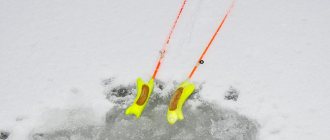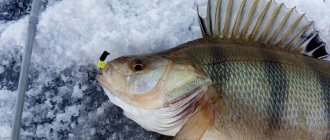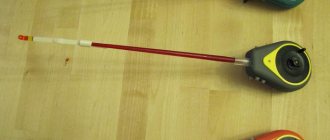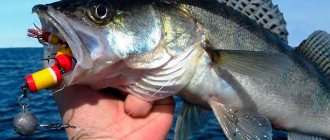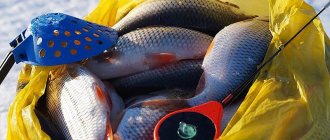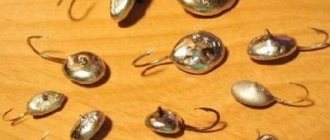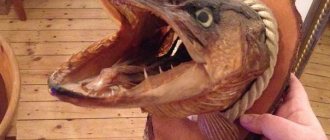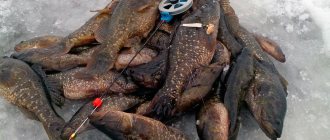The best reelless baits for perch: everything new is well forgotten old
The models listed below have been relevant for decades, and at the same time they catch great perch, are simple and unpretentious in wiring. Every angler who goes out on the ice has at least several of these in his bait box. The main working color is silver and, a little less often, copper. In fishing with jigs, an important detail is additional elements, such as beads, seed beads, balls, squares and others. Thanks to them, the same bait will attract attention in different ways, read about this below.
Witch
It is a bullet weight with a metal belt at the top. There are 3 free-swinging single hooks attached to the belt. As you dive, the hooks move up and down, attracting curious perch. It is important that the diameter of the wiring is significantly smaller than the diameter of the eye of the hooks and does not press them too tightly against the body. This will give high mobility and play.
Balda
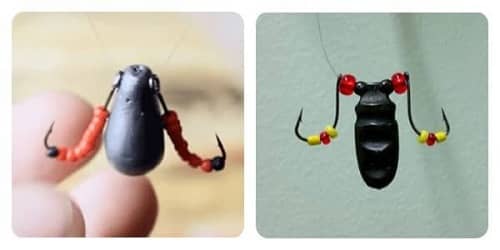
It somewhat resembles a witch, but has a different structure. On both sides of the bullet weight there are 2 hooks attached to the fishing line. Moving freely on it, they animate beautifully underwater. When lowering the load to the bottom, several knocks are made on it, due to which a cloud of turbidity and dust rises - which works great on the striped one. Read the article on fishing for bullfish.
Ant
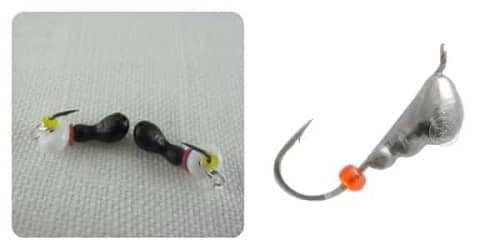
Perfectly copies the body and shape of the insect of the same name. Shows good results when fishing in shallow water. On the first and last ice, larger specimens are used, and throughout the winter, small and medium-sized models are preferable. Smooth rocking and high-frequency play of wiring is number one for the ant.
Devil
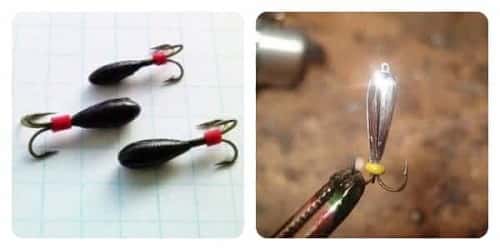
A nozzle jig that every angler should have. At some moments, only she works on the perch. A simple and very catchy shape: an elongated symmetrical body with a tee at the end. The presence of a bead or ball at the base of the hook is mandatory. Its colors are standard: yellow, red, green. The color is not necessarily uniform; there may be stripes or dots on it.
Nymph
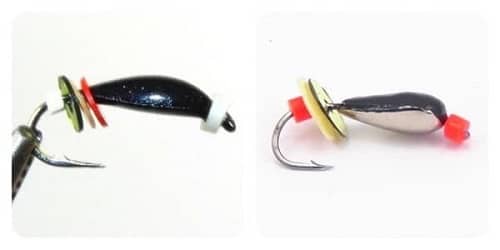
The most versatile and catchable nozzle jig. An excellent option for both beginners and experienced fishermen. Catches in any weather and under any circumstances. The catches include roach, bream and other whitefish. Its play resembles the larva of a stonefly butterfly. According to its shape, it is divided into teardrop-shaped and elongated. The best depth is 2-5 meters; deeper and in the current it is necessary to tie heavier nymphs.
Uralka
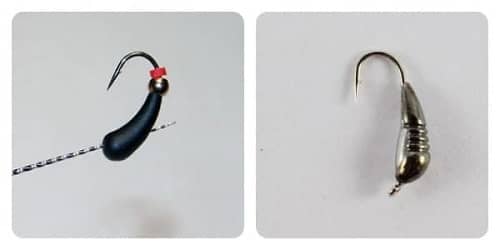
Popular and works great for perch. The shape is elongated and curved, tapering towards the hook. The bycatch often includes bream. The main distinguishing feature is the ability to work at great depths. Due to their shape and weight, not all jigs are able to play there; they are carried away by the current.
cat's eye
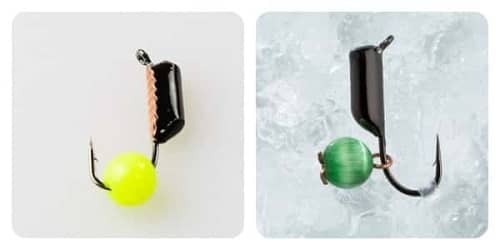
If there is a large ball on the jig, sometimes disproportionate to the body, it is most likely a cat’s eye. There are several variations of its location: directly on the hook and suspended from it. The idea is simple: during wiring, the bead creates a knocking sound, additionally attracting fish not only by vibration, but also by sound. It is allowed to fix the bead motionlessly, where it is the point of attack and an irritant.
Goat

It practically copies the shape of the Uralka, but with the only difference: the goat’s rewinder uses a double. Perhaps the paws remind the predator of an insect, a small arthropod. In addition, a double hook changes not only the appearance of the bait, but also the nature of the game. Thus, by changing 1 element we get two different jigs.
Banana
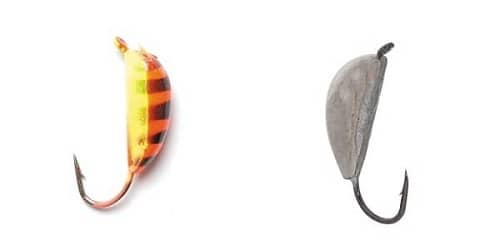
It will be difficult for beginners, as it is demanding on wiring. There are no additional elements on the banana, such as beads, cambrics or balls. Absolutely naked and simple, but with its own interesting and tempting game. We do not recommend upgrading it yourself; this will negatively affect the game and bites.
Carnation (nail ball and nail cube)
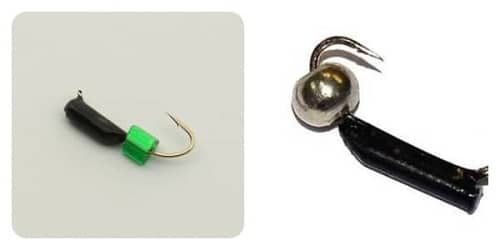
One of the most popular rewinders. There are fishermen who use only these types in their fishing, and are constantly with their catch. They work on: perch, bream, roach. There is a metal ball or cube on the shank of the hook. In both cases, thanks to them, a characteristic sound is created due to impacts on the body, attracting and irritating the fish.
Self-production
It is relatively easy to make a simple reelless bait for perch with your own hands. To do this, the fisherman will only need those components that can easily be found at home:
- It’s easy to make a “devil” yourself. It is enough to take a tee of a suitable size or put three single hooks together (you need to bite off the rings for the fishing line from two of them using wire cutters or pliers). The shank of the hook or hooks folded together must be tinned using a soldering iron and ordinary rosin. After this, a layer of tin in the shape of a spindle of the required thickness is applied with a soldering iron. In the future, the body of the jig can be varnished, and beads can be placed on the hooks.
- The simplest “pellet” can be made from a hook and a small sinker in the shape of a pellet. The ring of the hook must be bent using pliers at an angle of 30-45 degrees relative to the fore-end. The shank of the hook (near the ring itself) is inserted into the slot of the pellet one third of its depth and clamped there with pliers.
- Another way to make jigs yourself can be demonstrated using the example of a “goat”. The catchability of this homemade product is not inferior to the best examples of factory baits:
- Either a ready-made double is taken, or soldered from two single hooks. Using pliers, the shank of the hook is slightly bent inward. This is done to give the characteristic curved shape inherent in the “Ural” and “goat”.
- A thin strip of the same thickness is cut from sheet lead about a millimeter thick. Using a hammer, you need to gently tap the sharp edges of this strip to give it a more rounded shape. The final shape of lead wire is given by rolling it using a file (or something similar in shape). It is strictly not recommended to file down uneven lead wire - lead is poisonous, and its dust can get into the lungs.
- The resulting lead wire is wrapped in tight turns around the shank of the hook, forming the body of the bait, which in appearance resembles maggots. The excess wire is cut off, the ends are pressed with pliers along the body of the jig, fixing them, and finally forming the jig itself.
- The bait is basically ready, but you can further improve it by putting beads on the hooks. Additionally, you can wrap thin copper wire around the gaps between the lead windings, making the body of the “goat” striped.
How to assemble the right fishing rod
The basis of ice fishing is the correct choice of gear. A lot will depend on their characteristics. Of course, you can fish even with a twig of a bush growing along the shore and you will still be able to catch a perch. We are talking about convenience and sensitivity, from which anglers get genuine pleasure.
- Fishing rod. Due to the small size and weight of jigs, an appropriate rod is required. A balalaika with a total length of 30 cm with a whip of 20 cm is best suited. Such models are almost weightless, about 30 grams. Choose a warm handle material: EVA, foam, good plastic, wood.
- Fishing line. Use only special winter monofilaments. They tolerate cold and stress much better. They do not rub against holes or sharp ice, and also stretch well without stiffening in the cold. Diameter from 0.06-0.16 mm. Rule: Line diameter decreases as the size and weight of the reel decrease. Universal size 0.10-0.12 mm.
- Nod. One of the main elements of a winter fishing rod. A metal or mylar nod would be the best choice. It should be elastic, but at the same time not collapse under the weight of the bait and its action. The length and material of manufacture are selected based on personal preference. We recommend that you first use the one that is recommended in the store, and while fishing, evaluate all the advantages and disadvantages.
The most correct option would be to equip several balalaikas at once. They can have the same length, but differ in the nods and thickness of the wound fishing line. On a pond, depending on the conditions and the mower used, one or another model is selected. This way you will be completely ready to fish.
How to further improve the tackle
Lures, whatever they are, appeal to several of the fish's senses. Thanks to hearing and vision, the perch reacts faster to an object, making a decision to attack. The first thing he hears is vibrations and sounds made. This can be not only vibrations from the game, but also impacts on the ground. After that, he swims towards the sound and the second sense is activated - vision.
To improve bites, some reelless models are equipped with:
- Beads of different colors and sizes.
- Cambrics.
- Hanging or hanging metal balls and cubes.
- Flies with different lengths of pile.
The classic colors preferred by perch are red, yellow, black with multi-colored stripes. It is worth understanding that there are no universal options; always have several identical jigs with different shades of body kits.
Reelless jigs
Let's look at the reelless jigs themselves for winter fishing for perch. As with other lures, there is debate among anglers about the best reelless baits for perch. The truth is that there is no single best option. Under certain conditions, at a specific time, the devil will show himself. On another body of water, catching perch in winter with a witch will work effectively.
It is possible to say exactly which reeler is the most catchy for perch only in a specific body of water and at a certain time. Therefore, it is better to have various baits of various configurations in stock. All of them, depending on their weight and body shape, play differently during the retrieve, so it’s difficult to predict in advance what the perch will react to this time. This is already checked on the ice during reconnaissance fishing.
During periods of activity or short feeding, which are frequent but short-lived, the perch grabs everything. During passive standing, the striped predator is a lazy picky eater. And this is where assorted options for mothless rifles come in handy. What will work and attract the striped one - only practice will tell you. Perch responds better to short and pot-bellied reelless fish (for example, devils).
It is desirable to have a shiny plate-spoon on the body of the bait. Black almost always works (especially in clear water, shallow water and good light conditions). Sometimes bright red, green or yellow combinations remain out of competition. Everything is useful, from small tungsten jigs to relatively large ants, devils and goats.
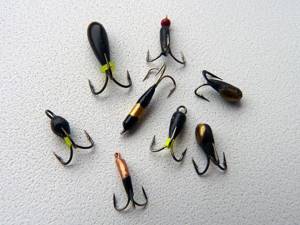
Jigs without bait for perch:
- All baited jigs with artificial decoration on the hook (pellets, bugs, oats, droplets) are good perch baitless baits;
- Ant;
- Nymph;
- Riga banana;
- Devils, goats;
- Witch, idiot;
- Uralka;
- Cat's eye, carnation with cube
- Column;
- Carnation with ball
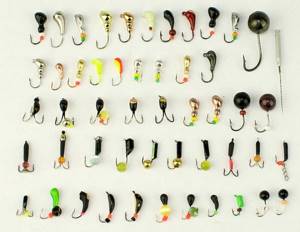
Jewelry is the main working element
All working reelless baits for perch are united by a catchy combination of decorations on the bait hook. If the vibrations of the jig attract a predator from afar, the striped fish visually observes the decorations close up, making a decision to attack. It is this part of the bait that serves as the point of attack and the last link of fishing, forcing the perch to grab the stimulus. It can be:
- Multi-colored balls of beads threaded onto a hook or through a wire fastening;
- Beads;
- Villi and hairs;
- Cambrics.
What color of beads does bass like on a reelless bait? Traditionally, it is red. But this shade does not always show itself perfectly. Closer to spring (and deep winter), brown, brown, green tones, similar to the color of amphipods, often work better. Sometimes combinations of black and yellow, as well as red and green, work well. Here, too, you need to experiment and search during fishing.
The use of additional hook suspension with beads or wool, as well as tandems and locomotives from the lower large and upper small rewinders, has proven itself to be effective. Moreover, the perch in such rigs bites mainly on this provocateur hook.
Fishing tactics or where to start
Reelless fishing, in preparation, is no different from other methods. After all the gear is collected, you need to find a place where the perch is standing. On familiar bodies of water, you should already know the approximate points, but what if this is your first fishing trip?
Follow our recommendations:
- On small rivers and lakes, start fishing from the shore to the center.
- Drill 10 holes in a checkerboard pattern, with a distance of 3 m between them.
- On large bodies of water, look where the majority are sitting and sit nearby without disturbing the others.
- If possible, purchase an echo sounder; it will quickly help you determine the bottom topography.
- Humpback whales do not travel in packs; they always stay separate from the main pack.
- Take turns fishing each hole, without staying near it for more than 5 minutes if there is no bite.
- Where the fish bites, you feed (optional).
- If there is a bite, but not intense, make another 3-4 holes around this place with a distance of 2 meters between them. Perch may be nearby.
- If there is a bite, don’t waste time, cast the reeler as soon as possible before the fish leaves.
- Remember the catch points and return to them in 20-30 minutes.
Perch behavior depending on the winter month
Perch lives in different parts of the water area not only depending on the time of year, but also the month. By understanding the principles by which a predator operates, it is possible to identify more promising places for fishing at a given time.
- On the first ice it stays in the coastal zone, near thickets, reeds, grass, snags, and flooded bushes. A depth of up to several meters is optimal; there are both medium and large specimens here.
- In January it goes to depths of up to 8 meters. The sooner the frosts begin, the sooner it moves into the pits. The striped fish actively moves - it pursues whitefish and fry, its main diet.
- The most difficult stage begins in the wilderness. Having firmly established itself in deep areas, the fish is in no hurry to bite; it is lethargic and sleepy. In order to provoke it into an attack, you will have to try very hard, selecting both a nozzle-less jig and wiring.
Fishing
The process of catching perch with a reelless bait in winter is very interesting, although it requires good physical fitness, since you may need to drill dozens of holes. Finding fish is important:
- Arriving at the reservoir, you should drill about 5 holes, ranking them as their depth increases.
- It is best to use a “devil” as a starting jig. Start fishing in the hole located in the shallowest place.
- Start playing with a jig from the bottom, moving almost to the hole itself (if the depth was very small - a meter or less). At the top point of the retrieve when fishing for perch, there is no point in making a hook, as when catching other fish. Perch bites much more greedily.
- If the fish bites right away, good. The touch of the fish to the bait was visible (and the tackle is extremely sensitive - it almost shows the “breathing” of the perch), but there was no real bite - it makes sense to replace the jig or change the tactics of playing with the bait. If 5 postings were made, and there were no signs of fish, you should change the hole to one that is located further to the depth. In the same case, when all five holes turned out to be “empty”, it makes sense to move to another place on the reservoir, located at a distance from the place of the first attempt.
- The bite stopped after a while - you need to change the jig. The perch is attracted by the noise that arises during the fishing process, it flocks from all over the area to the hole, but the jig has already become familiar and it is wary. If it is active, you can fish on one hole all day, changing baits from time to time. If after replacing two or three baits the fish was still not found, you need to go to another hole, preferably no closer than 20 meters. At a shorter distance there may no longer be fish. Exceptions are places with complex underwater terrain - stones, snags, flooded bushes. Those places need to be fished as carefully as possible, since this is where both perch and other underwater inhabitants like to be.
- An echo sounder will be a good helper for winter fishing. It will show the presence of fish, its size and the water horizon in which it is located.
Winter reelless fishing is an ocean of endless possibilities for experimenting and finding the best fishing methods and tactics.
You shouldn't be afraid to learn something new or be disappointed when you fail. The pleasure of being united with nature will in any case outweigh everything.
Which wiring to use
The wiring is selected depending on the activity of the fish. Basic rules: the more timid and cautious the perches, the smaller the bait should be and the smoother the retrieve. We recommend starting with active play and a medium-sized jig. If there is no bite, then the tackle is changed to smaller ones, the game becomes slower, with less amplitude.
Initial search techniques:
- Classical. The rewinder descends and lies on the bottom. Shaking, with frequent vibrations and a small amplitude, it begins to rise upward. Having raised the bait to the possible level, a pause of several seconds is maintained and the actions are repeated.
- Spare. If there is no activity with the classical technique, the second method is used. Having sunk to the bottom, the tackle begins to slowly rise with swaying of low frequency but high amplitude. This technique is suitable for lethargic, passive fish.
What are the basic posting methods:
- Active. The jig is placed on the bottom, rises 5-10 cm, waits a few seconds and falls to the bottom. The actions are repeated.
- Passive. Used for flaccid fish. Smoothly lift the tackle and stop the wiring at regular intervals and continue lifting.
- Simple wiring. Raise the tackle at low speed with even movements. It is important to avoid hesitation.
- Tapping the bottom. After tapping the jig several times on the bottom, use one of the above-mentioned postings in such a way that each subsequent rise is closer to the hole.
You have the right to use absolutely any movements, pauses and amplitudes; everything written above is just recommendations. Once you try to fish with a reelless bait, you will immediately understand what to do. Advice: if you are not alone on the pond, then look around what kind of wiring other fishermen use. Pay attention to those who have bites. This way you can quickly determine the mood and preferences of the perch right now.
Catchless reelers
In my practice, reelless baits of bright, both single-color and mixed colors have proven themselves well for catching perch. Jigs can be colored in a combination of yellow and brown, red and brown, or green. The most catchy jigs are goat and devil of these colors.
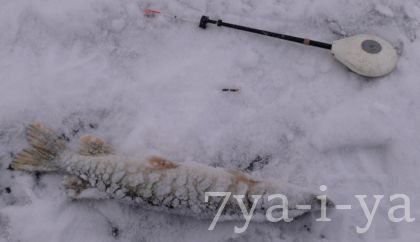
Sometimes perch can be caught using baits of other colors. But in my experience, white fish such as roach and bream are more likely to bite on black or neutral colors. It happens that a pike takes a bait and a pike perch is caught. How to catch pike perch and white fish is a separate topic, but pike are not specially caught with a reelless bait and are often caught in the bycatch and are small.
Is it worth using bait?
Groundbait is an integral part of fishing with reelless jigs. You can walk and look for fish for hours; it is much more effective to try to lure it. The first step is to decide on the location of the holes. After drilling, each of them is fed with 1-2 handfuls of the mixture.
We recommend using a winter feeder - it will deliver the bait directly under the hole. It is advisable to choose places with different terrain and depth. Thus, in a short time, you will fish at different depths and understand where the fish are.
It is important to use feed from animal species, this can be:
- bloodworm (the best option)
- maggot
- pieces of beef (chicken) liver.
- ready dry mixture.
The main ingredient is blood, which can lure perch from long distances. Therefore, it is often added to dry mixtures. In cold water, odors spread even faster and sharper, this enhances the effect.
Methods for catching perch with a reelless bait
There are 2 ways to equip gear for catching perch: with and without a nod:
- The use of a reelless jig requires the presence of a flexible nod with high sensitivity to vibrations in the aquatic environment. However, given that it can be made at home from steel, which has springy properties, this limitation does not pose a problem. The disadvantage of this type of equipment is the effect of some sagging of the fishing line and the possibility of the fish leaving due to this circumstance.
- The use of fishing rods without a nod for this jig is characterized by a reduction in the number of idle hooks due to the sufficient sensitivity and flexibility of the tackle whip, which ensures good fishing performance.
Fishing behavior
Although there is an opinion that fish are not afraid of noise on ice, I still advise you to be quieter. In practice, I have noticed that a running machine, noisy company and music do not greatly attract large fish, and sometimes they can scare away small ones. And vice versa, a fisherman who moves away from such company and enters nirvana with nature will always be rewarded with a good bite. Many underwater videos have been shot about how fish are afraid of noise on ice.
Another video: are fish afraid of noise on ice?
Several general unwritten rules of behavior for anglers.
